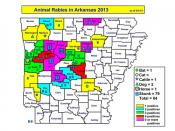A good one for a couple of extra credit points. "Well done."
Rabies
Rabies is an infectious disease of animals which is a member of a group of viruses constituting the family Rhabdoviridae. The virus particle is covered in a fatty membrane, is bullet-shaped, 70 by 180 nanometres and contains a single helical strand of ribonucleic acid (RNA).
Although rabies is usually spread among domestic dogs and wild carnivorous animals, all warm-blooded animals are susceptible to infection. The virus is often present in the salivary glands of infected animals, referred to as rabid, and is excreted in the saliva. The bite of the infected animal easily introduces the virus into a fresh wound. In humans, rabies is not usually spread from man to man, rather the majority of infections occur from rabid dogs. After a person has been inoculated, the virus enters small nerve ends around the site of the bite, and slowly travels up the nerve to reach the central nervous system (CNS) where it reproduces itself, and will then travel down nerves to the salivary glands and replicate further.
The time it takes to do this depends on the length of the nerve it must travel - a bite on the foot will have a much lengthier incubation period than a facial bite would. This period may last from two weeks to six months, and often the original wound will have healed and been forgotten by the time symptoms begin to occur.
Symptoms in humans present themselves in one of two forms: 'furious rabies', or 'dumb rabies'. The former is called such because of the severe nature and range of the symptoms. The virus, upon reaching the CNS will present the person with headache, fever, irritability, restlessness and anxiety. Progression may occur on to muscle pains, excessive salivation,


